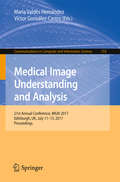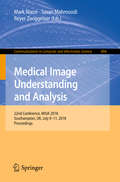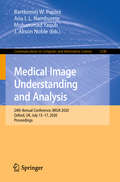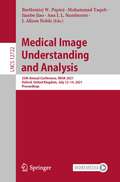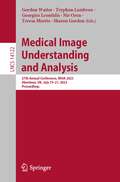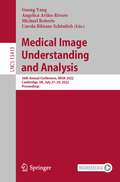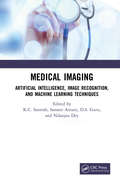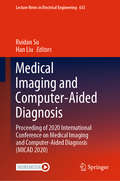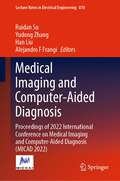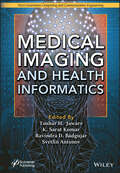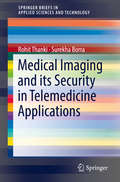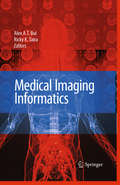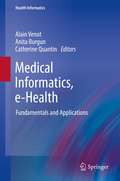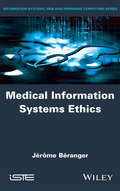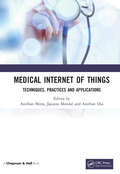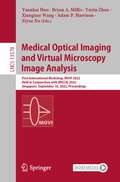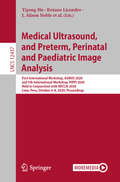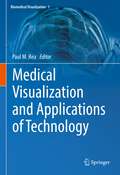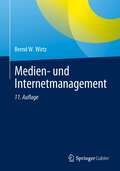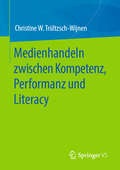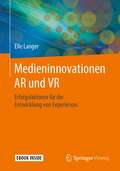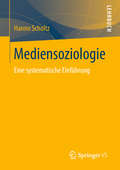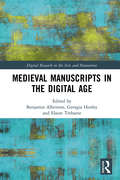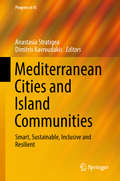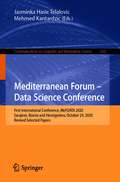- Table View
- List View
Medical Image Understanding and Analysis: 21st Annual Conference, MIUA 2017, Edinburgh, UK, July 11–13, 2017, Proceedings (Communications in Computer and Information Science #723)
by Víctor González-Castro María Valdés HernándezThis book constitutes the refereed proceedings of the 21st Annual Conference on Medical Image Understanding and Analysis, MIUA 2017, held in Edinburgh, UK, in July 2017.The 82 revised full papers presented were carefully reviewed and selected from 105 submissions. The papers are organized in topical sections on retinal imaging, ultrasound imaging, cardiovascular imaging, oncology imaging, mammography image analysis, image enhancement and alignment, modeling and segmentation of preclinical, body and histological imaging, feature detection and classification.The chapters 'Model-Based Correction of Segmentation Errors in Digitised Histological Images' and 'Unsupervised Superpixel-Based Segmentation of Histopathological Images with Consensus Clustering' are open access under a CC BY 4.0 license.
Medical Image Understanding and Analysis: 22nd Conference, Miua 2018, Southampton, Uk, July 9-11, 2018, Revised Selected Papers (Communications In Computer And Information Science #894)
by Mark Nixon Sasan Mahmoodi Reyer ZwiggelaarThis book constitutes the refereed proceedings of the 22st Annual Conference on Medical Image Understanding and Analysis, MIUA 2018, held in Southampton, UK, in July 2018.The 34 revised full papers presented were carefully reviewed and selected from 49 submissions. The papers are organized in topical sections on liver analysis, medical image analysis, texture and image analysis, MRI: applications and techniques, segmentation in medical images, CT: learning and planning, ocular imaging analysis, applications of medical image analysis.
Medical Image Understanding and Analysis: 24th Annual Conference, MIUA 2020, Oxford, UK, July 15-17, 2020, Proceedings (Communications in Computer and Information Science #1248)
by Bartłomiej W. Papież Ana I. L. Namburete Mohammad Yaqub J. Alison NobleThis book constitutes the refereed proceedings of the 24th Conference on Medical Image Understanding and Analysis, MIUA 2020, held in July 2020. Due to COVID-19 pandemic the conference was held virtually. The 29 full papers and 5 short papers presented were carefully reviewed and selected from 70 submissions. They were organized according to following topical sections: image segmentation; image registration, reconstruction and enhancement; radiomics, predictive models, and quantitative imaging biomarkers; ocular imaging analysis; biomedical simulation and modelling.
Medical Image Understanding and Analysis: 25th Annual Conference, MIUA 2021, Oxford, United Kingdom, July 12–14, 2021, Proceedings (Lecture Notes in Computer Science #12722)
by Bartłomiej W. Papież Mohammad Yaqub Jianbo Jiao Ana I. L. Namburete J. Alison NobleThis book constitutes the refereed proceedings of the 25th Conference on Medical Image Understanding and Analysis, MIUA 2021, held in July 2021. Due to COVID-19 pandemic the conference was held virtually. The 32 full papers and 8 short papers presented were carefully reviewed and selected from 77 submissions. They were organized according to following topical sections: biomarker detection; image registration, and reconstruction; image segmentation; generative models, biomedical simulation and modelling; classification; image enhancement, quality assessment, and data privacy; radiomics, predictive models, and quantitative imaging.
Medical Image Understanding and Analysis: 27th Annual Conference, MIUA 2023, Aberdeen, UK, July 19–21, 2023, Proceedings (Lecture Notes in Computer Science #14122)
by Gordon Waiter Tryphon Lambrou Georgios Leontidis Nir Oren Teresa Morris Sharon GordonThis book constitutes the proceedings of the 27th Annual Conference on Medical Image Understanding and Analysis, MIUA 2023, which took place in Aberdeen, UK, during July 19–21, 2023.The 24 full papers presented in this book were carefully reviewed and selected from 42 submissions. They were organized in topical sections as follows: Image interpretation; radiomics, predictive models and quantitative imaging; image classification; and biomarker detection.
Medical Image Understanding and Analysis: 26th Annual Conference, MIUA 2022, Cambridge, UK, July 27–29, 2022, Proceedings (Lecture Notes in Computer Science #13413)
by Guang Yang Angelica Aviles-Rivero Michael Roberts Carola-Bibiane SchönliebThis book constitutes the refereed proceedings of the 26th Conference on Medical Image Understanding and Analysis, MIUA 2022, held in Cambridge, UK, in July 2022. The 65 full papers presented were carefully reviewed and selected from 95 submissions. They were organized according to following topical sections: biomarker detection; image registration, and reconstruction; image segmentation; generative models, biomedical simulation and modelling; classification; image enhancement, quality assessment, and data privacy; radiomics, predictive models, and quantitative imaging.Chapter “FCN-Transformer Feature Fusion for Polyp Segmentation” is available open access under a Creative Commons Attribution 4.0 International License via link.springer.com.
Medical Imaging: Artificial Intelligence, Image Recognition, and Machine Learning Techniques (Advances in Intelligent Systems and Computing #651)
by K. C. Santosh Sameer Antani D. S. Guru Nilanjan DeyThe book discusses varied topics pertaining to advanced or up-to-date techniques in medical imaging using artificial intelligence (AI), image recognition (IR) and machine learning (ML) algorithms/techniques. Further, coverage includes analysis of chest radiographs (chest x-rays) via stacked generalization models, TB type detection using slice separation approach, brain tumor image segmentation via deep learning, mammogram mass separation, epileptic seizures, breast ultrasound images, knee joint x-ray images, bone fracture detection and labeling, and diabetic retinopathy. It also reviews 3D imaging in biomedical applications and pathological medical imaging.
Medical Imaging and Computer-Aided Diagnosis: Proceeding of 2020 International Conference on Medical Imaging and Computer-Aided Diagnosis (MICAD 2020) (Lecture Notes in Electrical Engineering #633)
by Han Liu Ruidan SuThis book covers virtually all aspects of image formation in medical imaging, including systems based on ionizing radiation (x-rays, gamma rays) and non-ionizing techniques (ultrasound, optical, thermal, magnetic resonance, and magnetic particle imaging) alike. In addition, it discusses the development and application of computer-aided detection and diagnosis (CAD) systems in medical imaging. Given its coverage, the book provides both a forum and valuable resource for researchers involved in image formation, experimental methods, image performance, segmentation, pattern recognition, feature extraction, classifier design, machine learning / deep learning, radiomics, CAD workstation design, human–computer interaction, databases, and performance evaluation.
Medical Imaging and Computer-Aided Diagnosis: Proceedings of 2022 International Conference on Medical Imaging and Computer-Aided Diagnosis (MICAD 2022) (Lecture Notes in Electrical Engineering #810)
by Ruidan Su Yudong Zhang Han Liu Alejandro F FrangiThis book covers virtually all aspects of image formation in medical imaging, including systems based on ionizing radiation (x-rays, gamma rays) and non-ionizing techniques (ultrasound, optical, thermal, magnetic resonance, and magnetic particle imaging) alike. In addition, it discusses the development and application of computer-aided detection and diagnosis (CAD) systems in medical imaging. Given its coverage, the book provides both a forum and valuable resource for researchers involved in image formation, experimental methods, image performance, segmentation, pattern recognition, feature extraction, classifier design, machine learning / deep learning, radiomics, CAD workstation design, human–computer interaction, databases, and performance evaluation.
Medical Imaging and Health Informatics (Next Generation Computing and Communication Engineering)
by K. Sarat Kumar Svetlin Antonov Tushar H. Jaware Ravindra D. BadgujarMEDICAL IMAGING AND HEALTH INFORMATICS Provides a comprehensive review of artificial intelligence (AI) in medical imaging as well as practical recommendations for the usage of machine learning (ML) and deep learning (DL) techniques for clinical applications. Medical imaging and health informatics is a subfield of science and engineering which applies informatics to medicine and includes the study of design, development, and application of computational innovations to improve healthcare. The health domain has a wide range of challenges that can be addressed using computational approaches; therefore, the use of AI and associated technologies is becoming more common in society and healthcare. Currently, deep learning algorithms are a promising option for automated disease detection with high accuracy. Clinical data analysis employing these deep learning algorithms allows physicians to detect diseases earlier and treat patients more efficiently. Since these technologies have the potential to transform many aspects of patient care, disease detection, disease progression and pharmaceutical organization, approaches such as deep learning algorithms, convolutional neural networks, and image processing techniques are explored in this book. This book also delves into a wide range of image segmentation, classification, registration, computer-aided analysis applications, methodologies, algorithms, platforms, and tools; and gives a holistic approach to the application of AI in healthcare through case studies and innovative applications. It also shows how image processing, machine learning and deep learning techniques can be applied for medical diagnostics in several specific health scenarios such as COVID-19, lung cancer, cardiovascular diseases, breast cancer, liver tumor, bone fractures, etc. Also highlighted are the significant issues and concerns regarding the use of AI in healthcare together with other allied areas, such as the Internet of Things (IoT) and medical informatics, to construct a global multidisciplinary forum. Audience The core audience comprises researchers and industry engineers, scientists, radiologists, healthcare professionals, data scientists who work in health informatics, computer vision and medical image analysis.
Medical Imaging and its Security in Telemedicine Applications (SpringerBriefs in Applied Sciences and Technology)
by Rohit Thanki Surekha BorraThis book introduces medical imaging, its security requirements, and various security mechanisms using data hiding approaches. The book in particular provides medical data hiding techniques using various advanced image transforms and encryption methods. The book focuses on two types of data hiding techniques: steganography and watermarking for medical images. The authors show how these techniques are used for security and integrity verification of medical images and designed for various types of medical images such as grayscale image and color image. The implementation of techniques are done using discrete cosine transform (DCT), discrete wavelet transform (DWT), singular value decomposition (SVD), redundant DWT (RDWT), fast discrete curvelet transform (FDCuT), finite ridgelet transform (FRT) and non-subsampled contourlet transform (NSCT). The results of these techniques are also demonstrated after description of each technique. Finally, some future research directions are provided for security of medical images in telemedicine application.
Medical Imaging Informatics
by Ricky K. Taira Alex A.T. BuiMedical Imaging Informatics provides an overview of this growing discipline, which stems from an intersection of biomedical informatics, medical imaging, computer science and medicine. Supporting two complementary views, this volume explores the fundamental technologies and algorithms that comprise this field, as well as the application of medical imaging informatics to subsequently improve healthcare research. Clearly written in a four part structure, this introduction follows natural healthcare processes, illustrating the roles of data collection and standardization, context extraction and modeling, and medical decision making tools and applications. Medical Imaging Informatics identifies core concepts within the field, explores research challenges that drive development, and includes current state-of-the-art methods and strategies.
Medical Informatics, e-Health: Fundamentals and Applications
by Catherine Quantin Alain Venot Anita BurgunThanks to this book, it will be possible for readers to understand Health Informatics as a young scientific discipline compared to general computing, bioinformatics, bioengineering and medicine. The book introduces major journals in the field, major conferences, the national and international structures of the discipline, and the major sources of funding. Readers will find in the book the fundamentals of the large terminological resources in Health which are very difficult to understand (thesauri, classifications, ontology...). In terms of application, the book will include the main features of the software developed in the major structures of Health (hospital information systems, computerization of medical and dental practice, and pharmacies) with applications in various countries. The book will consider the ongoing revolution linked to the development of telemedicine and, more generally, to e-Health, smart home and disability help. Human factors, development of user interfaces will be considered.
Medical Information Systems Ethics
by Jérôme BérangerThe exponential digitization of medical data has led to a transformation of the practice of medicine. This change notably raises a new complexity of issues surrounding health IT. The proper use of these communication tools, such as telemedicine, e-health, m-health the big medical data, should improve the quality of monitoring and care of patients for an information system to "human face". Faced with these challenges, the author analyses in an ethical angle the patient-physician relationship, sharing, transmission and storage of medical information, setting pins to an ethic for the digitization of medical information. Drawing on good practice recommendations closely associated with values, this model is developing tools for reflection and present the keys to understanding the decision-making issues that reflect both the technological constraints and the complex nature of human reality in medicine .
Medical Internet of Things: Techniques, Practices and Applications
by Anirban MitraIn recent years, the Medical Internet of Things (MIoT) has emerged as one of the most helpful technological gifts to mankind. With the incredible development in data science, big data technologies, IoT and embedded systems, it is now possible to collect a huge amount of sensitive and personal data, compile it and store it through cloud or edge computing techniques. However, important concerns remain about security and privacy, the preservation of sensitive and personal data, and the efficient transfer, storage and processing of MIoT-based data. Medical Internet of Things: Techniques, Practices and Applications is an attempt to explore new ideas and novel techniques in the area of MIoT. The book is composed of fifteen chapters discussing basic concepts, issues, challenges, case studies and applications in MIoT. This book offers novel advances and applications of MIoT in a precise and clear manner to the research community to achieve in-depth knowledge in the field. This book will help those interested in the field as well as researchers to gain insight into different concepts and their importance in multifaceted applications of real life. This has been done to make the book more flexible and to stimulate further interest in the topic. Features: A systematic overview of concepts in Medical Internet of Things (MIoT) is included. Recent research and some pointers on future advancements in MIoT are discussed. Examples and case studies are included. It is written in an easy-to-understand style with the help of numerous figures and datasets. This book serves as a reference book for scientific investigators who are interested in working on MIoT, as well as researchers developing methodology in this field. It may also be used as a textbook for postgraduate-level courses in computer science or information technology.
Medical Optical Imaging and Virtual Microscopy Image Analysis: First International Workshop, MOVI 2022, Held in Conjunction with MICCAI 2022, Singapore, September 18, 2022, Proceedings (Lecture Notes in Computer Science #13578)
by Yuankai Huo Bryan A. Millis Yuyin Zhou Xiangxue Wang Adam P. Harrison Ziyue XuThis book constitutes the refereed proceedings of the 1st International Workshop on Medical Optical Imaging and Virtual Microscopy Image Analysis, MOVI 2022, held in conjunction with the 25th International Conference on Medical Imaging and Computer-Assisted Intervention, MICCAI 2022, in Singapore, Singapore, in September 2022. The 18 papers presented at MOVI 2022 were carefully reviewed and selected from 25 submissions. The objective of the MOVI workshop is to promote novel scalable and resource-efficient medical image analysis algorithms for high-dimensional image data analy-sis, from optical imaging to virtual microscopy.
Medical Ultrasound, and Preterm, Perinatal and Paediatric Image Analysis: First International Workshop, ASMUS 2020, and 5th International Workshop, PIPPI 2020, Held in Conjunction with MICCAI 2020, Lima, Peru, October 4-8, 2020, Proceedings (Lecture Notes in Computer Science #12437)
by Yipeng Hu Roxane Licandro J. Alison Noble Jana Hutter Stephen Aylward Andrew Melbourne Esra Abaci Turk Jordina Torrents BarrenaThis book constitutes the proceedings of the First International Workshop on Advances in Simplifying Medical UltraSound, ASMUS 2020, and the 5th International Workshop on Perinatal, Preterm and Paediatric Image Analysis, PIPPI 2020, held in conjunction with MICCAI 2020, the 23rd International Conference on Medical Image Computing and Computer-Assisted Intervention. The conference was planned to take place in Lima, Peru, but changed to an online event due to the Coronavirus pandemic. For ASMUS 2020, 19 contributions were accepted from 26 submissions; the 14 contributions from the PIPPI workshop were carefully reviewed and selected from 21 submissions. The papers were organized in topical sections named: diagnosis and measurement; segmentation, captioning and enhancement; localisation and guidance; robotics and skill assessment, and PIPPI 2020.
Medical Visualization and Applications of Technology (Biomedical Visualization #1)
by Paul M. ReaThis edited book explores the use of technology to enable us to visualize the life sciences in a more meaningful and engaging way. It will enable those interested in visualization techniques to gain a better understanding of the applications that can be used in visualization, imaging and analysis, education, engagement and training. The reader will also be able to learn about the use of visualization techniques and technologies for the historical and forensic settings. The reader will be able to explore the utilization of technologies from a number of fields to enable an engaging and meaningful visual representation of the biomedical sciences. We have something for a diverse and inclusive audience ranging from healthcare, patient education, animal health and disease and pedagogies around the use of technologies in these related fields. The first four chapters cover healthcare and detail how technology can be used to illustrate emergency surgical access to the airway, pressure sores, robotic surgery in partial nephrectomy, and respiratory viruses. The last six chapters in the education section cover augmented reality and learning neuroanatomy, historical artefacts, virtual reality in canine anatomy, holograms to educate children in cardiothoracic anatomy, 3D models of cetaceans, and the impact of the pandemic on digital anatomical educational resources.
Medien- und Internetmanagement
by Bernd W. WirtzDer Medien- und Kommunikationssektor hat sich zu einem zentralen Wirtschaftsbereich in der Informationsgesellschaft entwickelt. Dieses Buch behandelt das Medienmanagement für die elektronischen und printbasierten Medien. Vor dem Hintergrund der Branchenkonvergenz werden die grundlegenden Entwicklungen, Wertschöpfungsstrukturen, Geschäftsmodelle und Wettbewerbsstrategien im Rahmen einer integrierten Managementbetrachtung dargestellt. Darüber hinaus werden neuere Entwicklungen bei Internetmedien behandelt.
Medienhandeln zwischen Kompetenz, Performanz und Literacy
by Christine W. Trültzsch-WijnenDas Buch diskutiert die soziale und individuelle Bedingtheit von Medienkompetenz. Im Mittelpunkt steht die Frage, wie sich das Medienhandeln von Individuen im Hinblick auf deren Medienkompetenz, im Sinne eines sicheren und selbstbestimmten Handelns im Umgang mit Medien, erklären und beurteilen lässt. Dies setzt eine Betrachtung des Medienhandelns vor dem Hintergrund der Beziehungen zwischen der Kompetenz zu Handeln, als Summe von Fähigkeiten, Fertigkeiten und Wissen sowie der kognitiven Beherrschung von Regeln des Verhaltens (moralische Regeln, rechtliche Regeln sowie Regeln der Klugheit), und der Performanz, als tatsächliches Handeln eines Individuums, voraus. Dabei wird auf theoretischer Ebene der Frage nach der sozialen Determinierung eines selbstbestimmten Handelns im Umgang mit Medien einschließlich dafür erforderlicher Fähigkeiten, Fertigkeiten sowie des damit verbundenen Wissens nachgegangen. Außerdem wird das Verhältnis des deutschsprachigen Medienkompetenzdiskurses zum internationalen Diskurs über media literacy erläutert. Es werden Gemeinsamkeiten und Unterschiede herausgearbeitet und Potentiale für eine gegenseitige Befruchtung beider Perspektiven aufgezeigt. Darüber hinaus wird die empirische Relevanz und Anwendbarkeit dieser theoretischen Überlegungen anhand zweier Studien illustriert.
Medieninnovationen AR und VR: Erfolgsfaktoren für die Entwicklung von Experiences
by Elle LangerAugmented und Virtual Reality sind Medieninnovationen mit spezifischen Merkmalen. Sie erzeugen beim Nutzer eine Immersion, da der Nutzer in das Medium und seine 360° Umgebung hineintaucht. Um erfolgreich Inhalte und Anwendungen für AR und VR zu entwickeln, müssen psychologische Wirkungsweisen, die Besonderheiten der 360° Umgebung, die Geschichte und die Art der Mediennutzug mit den Bedürfnissen und Erlebnissen des Nutzers abgestimmt werden. Contentproduzenten stellt das vor neuartige Herausforderungen bei der Contententwicklung, der Methodenwahl, der Teamarbeit und dem gesamten Herstellungsprozess von AR und VR Experiences.Das Buch führt den Leser in die Merkmale der immersiven Medien ein und bietet ihm wissenschaftliche Belege und praxisrelevante Tipps, die ihm helfen, hochwertige und nutzerzentrierte Inhalte für die Immersiven Medien zu produzieren. Die wissenschaftlich hergeleiteten Erfolgsfaktoren in Form von Checklisten sind ein Leitfaden und eine ideale Grundlage, um den Herstellungsprozess zu standardisieren und die eigenen Projekte weiterzuentwickeln.
Mediensoziologie: Eine systematische Einführung
by Hanno ScholtzWas haben Veränderungen in Gesellschaften und ihren Medien miteinander zu tun? Wo tragen Medien zu gesellschaftlichen Problemen bei und wo können sie diese lösen helfen? Wie wird darüber in der Wissenschaft diskutiert, und wie hängen diese Diskussionen zusammen? Ausgehend von Individuen mit ihren Wahrnehmungen und Handlungsentscheidungen, den von ihnen begründeten Institutionen, und einer knappen Definition von Medien bietet dieser Einführungsband in die Mediensoziologie eine systematische Darstellung, die einen Überblick ermöglicht und Probleme und im Fach geführte Diskussionen einordnen lässt.
Medieval Manuscripts in the Digital Age (Digital Research in the Arts and Humanities)
by Benjamin AlbrittonMedieval Manuscripts in the Digital Age explores one major manuscript repository’s digital presence and poses timely questions about studying books from a temporal and spatial distance via the online environment. Through contributions from a large group of distinguished international scholars, the volume assesses the impact of being able to access and interpret these early manuscripts in new ways. The focus on Parker on the Web, a world-class digital repository of diverse medieval manuscripts, comes as that site made its contents Open Access. Exploring the uses of digital representations of medieval texts and their contexts, contributors consider manuscripts from multiple perspectives including production, materiality, and reception. In addition, the volume explicates new interdisciplinary frameworks of analysis for the study of the relationship between texts and their physical contexts, while centring on an appreciation of the opportunities and challenges effected by the digital representation of a tangible object. Approaches extend from the codicological, palaeographical, linguistic, and cultural to considerations of reader reception, image production, and the implications of new technologies for future discoveries. Medieval Manuscripts in the Digital Age advances the debate in manuscript studies about the role of digital and computational sources and tools. As such, the book will appeal to scholars and students working in the disciplines of Digital Humanities, Medieval Studies, Literary Studies, Library and Information Science, and Book History.
Mediterranean Cities and Island Communities: Smart, Sustainable, Inclusive and Resilient (Progress in IS)
by Anastasia Stratigea Dimitris KavroudakisThis book addresses the issue of smart and sustainable development in the Mediterranean (MED) region, a distinct part of the world, full of challenges and risks but also opportunities. Above all, the book focuses on smartening up small and medium-sized cities and insular communities, taking into account their geographical peculiarities, the pattern of MED urban settlements and the abundance of island complexes in the MED Basin. Taking for granted that sustainability in the MED is the overarching policy goal that needs to be served, the book explores different aspects of smartness in support of this goal’s achievement. In this respect, evidence from concrete smart developments adopted by forerunners in the MED region is collected and analyzed; coupled with experiences gathered from successful, non-MED, examples of smart efforts in European countries. More specifically, current research and empirical results from MED urban environments are discussed, as well as findings from or concerning other parts of the world, which are of relevance to the MED region. The book’s primary goal is to enable policymakers, planners and decision-making bodies to recognize the challenges and options available; and make to more informed policy decisions towards smart, sustainable, inclusive and resilient urban and regional futures in the MED.
Mediterranean Forum – Data Science Conference: First International Conference, MeFDATA 2020, Sarajevo, Bosnia and Herzegovina, October 24, 2020, Revised Selected Papers (Communications in Computer and Information Science #1343)
by Jasminka Hasic Telalovic Mehmed KantardzicThis book constitutes selected and revised papers from the First Mediterranean Forum - Data Science Conference, MeFDATA 2020, held in Sarajevo, Bosnia and Herzegovina, in October 2020. The 11 papers presented were carefully reviewed and selected from the 26 qualified submissions. The papers are organized in the topical sections on human behaviour and pandemic; applications in medicine; industrial applications; natural language processing.
